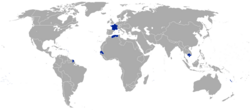French Empire Empire Français (French) | |||||||||||||||
|---|---|---|---|---|---|---|---|---|---|---|---|---|---|---|---|
| 1852–1870 | |||||||||||||||
| Anthem: "Partant pour la Syrie"[1] (de facto)[2][3] "Departing for Syria" | |||||||||||||||
 The Second French Empire in 1861 | |||||||||||||||
 Colonies and territories held by the Second French Empire in 1867, highlighted in blue | |||||||||||||||
| Capital | Paris 48°51′23″N 02°21′08″E / 48.85639°N 2.35222°E | ||||||||||||||
| Official languages | French | ||||||||||||||
| Religion |
| ||||||||||||||
| Demonym(s) | French | ||||||||||||||
| Government | Unitary autocracy (until 2 December 1852) Unitary absolute monarchy
(1869–1870) | ||||||||||||||
| Emperor | |||||||||||||||
• 1852–1870 | Napoleon III | ||||||||||||||
| Cabinet Chief | |||||||||||||||
• 1869–1870 | Émile Ollivier | ||||||||||||||
• 1870 | Charles de Palikao | ||||||||||||||
| Legislature | Parliament | ||||||||||||||
| Senate | |||||||||||||||
| Corps législatif | |||||||||||||||
| Historical era | New Imperialism | ||||||||||||||
| 2 December 1851 | |||||||||||||||
| 14 January 1852 | |||||||||||||||
• Empire proclaimed | 2 December 1852 | ||||||||||||||
| 19 July 1870 | |||||||||||||||
| 1 September 1870 | |||||||||||||||
| 4 September 1870 | |||||||||||||||
| 27 October 1870 | |||||||||||||||
| Currency | French franc | ||||||||||||||
| |||||||||||||||
| Today part of | France Algeria | ||||||||||||||
The Second French Empire,[a] officially the French Empire,[b] was the government of France from 2 December 1852 to 4 September 1870 between the Second and the Third French Republics. Ruled by Louis-Napoléon Bonaparte (Napoleon III), the period was one of significant achievements in infrastructure and economy, while France reasserted itself as the dominant power in Europe.
Historians in the 1930s and 1940s disparaged the Second Empire as a precursor of fascism,[4] but by the late 20th century it was re-evaluated as an example of a modernizing regime.[5][6] Historians have generally given the Second Empire negative evaluations on its foreign policy, and somewhat more positive assessments of domestic policies, especially after Napoleon III liberalised his rule after 1858. He promoted French business and exports. The greatest achievements included a railway network that facilitated commerce and tied the nation together with Paris as its hub. This stimulated economic growth and brought prosperity to most regions of the country. The Second Empire is credited with rebuilding of Paris with broad boulevards, striking public buildings, and elegant residential districts for wealthier Parisians.
Internationally, Napoleon III tried to emulate his uncle Napoleon Bonaparte, engaging in numerous imperial ventures around the world as well as several wars in Europe. He began his reign with French victories in Crimea and in Italy, gaining Savoy and Nice, and very briefly, Venetia (before in turn ceding to Italy). Using very harsh methods, he built up the French Empire in North Africa, in East Africa and in French Indochina. Napoleon III also launched an intervention in Mexico seeking to erect the Second Mexican Empire and bring it into the French orbit, but this ended in a fiasco. He mishandled the Prussian threat, and by the end of his reign, the French emperor found himself without allies in the face of overwhelming German forces.[7] His rule was ended during the Franco-Prussian War, when he was captured by the Prussian army at Sedan in 1870 and dethroned by French republicans. He died in exile in 1873 in England.
- ^ White, Richard Grant (1861). National Hymns. How They are Written and how They are Not Written: A Lyric and National Study for the Times. New York City, New York: Rudd & Carleton. p. 59.
- ^ Sousa, John Philip (1890). National, Patriotic and Typical: Airs of All Lands. Philadelphia, Pennsylvania: H. Coleman. pp. vii, 100.
- ^ Martens, Frederick H. (1930). "Music Mirrors of the Second Empire: Part 1". The Musical Quarterly. 16 (3): 426. doi:10.1093/mq/XVI.3.415. JSTOR 738378.
- ^ Price (2015), p. 272.
- ^ Price (1996), pp. 4–10.
- ^ Spitzer (1962), pp. 308–329.
- ^ Wolf (1963), p. 275.
Cite error: There are <ref group=lower-alpha> tags or {{efn}} templates on this page, but the references will not show without a {{reflist|group=lower-alpha}} template or {{notelist}} template (see the help page).

